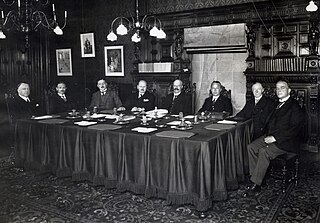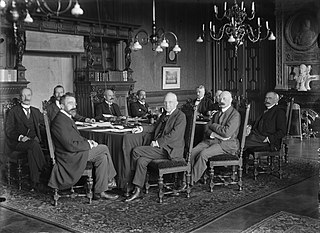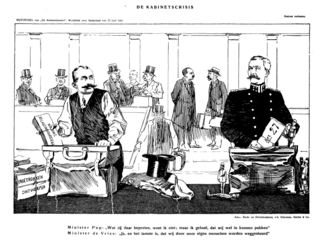
The Roman Catholic State Party was a Catholic Christian democratic political party in the Netherlands. The party was founded in 1926 as a continuation of the General League of Roman Catholic Electoral Associations. During its entire existence, the party was in government. In 1945 the party became the Catholic People's Party (KVP).

The General League of Roman Catholic Electoral Associations, informally called the General League, was a Catholic political party in the Netherlands. It existed from 1904 to 1926, when it was succeeded by the Roman Catholic State Party. It is one of the ancestors of today's Christian Democratic Appeal.

The minister of foreign affairs is the head of the Ministry of Foreign Affairs and a member of the Cabinet and the Council of Ministers. The incumbent minister is Caspar Veldkamp of the New Social Contract (NSC) party, who has been in office since 2 July 2024. Regularly, a state secretary is assigned to the ministry who is tasked with specific portfolios, currently the function is not in use. Additionally since 1965 there has been a minister without portfolio assigned to the ministry, the minister for foreign trade and development cooperation has traditionally development cooperation as portfolio, since 2012 the portfolio of trade and export has been assigned added to the function.

Petrus Josephus Mattheus "Piet" Aalberse Sr. was a Dutch politician of the General League of Roman Catholic Caucuses, later the Roman Catholic State Party (RKSP) and later co-founder of the Catholic People's Party (KVP) and jurist. He was granted the honorary title of Minister of State on 31 December 1934.

The Third Ruijs de Beerenbrouck cabinet was the cabinet of the Netherlands from 10 August 1929 until 26 May 1933. The cabinet was formed by the political parties Roman Catholic State Party (RKSP), Anti-Revolutionary Party (ARP) and the Christian Historical Union (CHU) after the 1929 general election. The centre-right cabinet was a majority government in the House of Representatives. It was the last of three cabinets of Charles Ruijs de Beerenbrouck as Chairman of the Council of Ministers.

The First Ruijs de Beerenbrouck cabinet was the cabinet of the Netherlands from 9 September 1918 until 18 September 1922. The cabinet was formed by the political parties Roman Catholic State Party (RKSP), Anti-Revolutionary Party (ARP) and the Christian Historical Union (CHU) after the election of 1918. The centre-right cabinet was a majority government in the House of Representatives. It was the first of three cabinets of Charles Ruijs de Beerenbrouck, the Leader of the Roman Catholic State Party as Prime Minister.

The minister of war of the Netherlands, was the minister responsible for the Ministry of War and the Royal Netherlands Army. The position was abolished with the creation of the position for Minister of Defence.

A cabinet formation took place in Netherlands after the general election of 3 July 1918. The formation led to the swearing-in of the first Ruijs de Beerenbrouck cabinet on 9 September 1918, compromising the Roman Catholic State Party (RKSP), the Anti-Revolutionary Party (ARP) and the Christian Historical Union (CHU).

A cabinet formation took place in the Netherlands after the first Ruijs de Beerenbrouck cabinet tendered its resignation on 16 June 1921. The resignation was prompted by ministerial crises involving Finance Minister Simon de Vries Czn and War Minister Willem Frederik Pop. During the formation, Prime Minister and formateur Charles Ruijs de Beerenbrouck selected Dirk Jan de Geer and Jannes van Dijk as their replacements. Additionally, the right-wing parties forming the cabinet — the Roman Catholic State Party (RKSP), the Anti-Revolutionary Party (ARP), and the Christian Historical Union (CHU) — reached an agreement on the substantive issues underlying the crises. The two new ministers were sworn in on 28 July 1921, marking the end of the formation.
A cabinet formation took place in the Netherlands following the general election of 5 July 1922. The formation resulted in the inauguration of the Second Ruijs de Beerenbrouck cabinet on 18 September 1922, comprising the General League of Roman Catholic Electoral Associations (AB), the Anti-Revolutionary Party (ARP), and the Christian Historical Union (CHU).



















